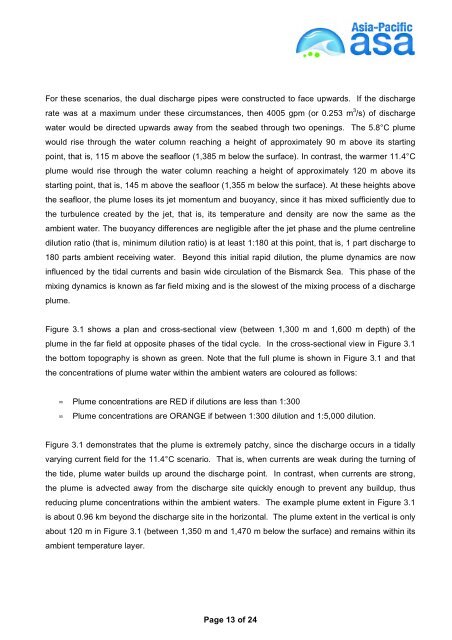Appendices 5-13 - Nautilus Cares - Nautilus Minerals
Appendices 5-13 - Nautilus Cares - Nautilus Minerals
Appendices 5-13 - Nautilus Cares - Nautilus Minerals
You also want an ePaper? Increase the reach of your titles
YUMPU automatically turns print PDFs into web optimized ePapers that Google loves.
For these scenarios, the dual discharge pipes were constructed to face upwards. If the discharge<br />
rate was at a maximum under these circumstances, then 4005 gpm (or 0.253 m 3 /s) of discharge<br />
water would be directed upwards away from the seabed through two openings. The 5.8°C plume<br />
would rise through the water column reaching a height of approximately 90 m above its starting<br />
point, that is, 115 m above the seafloor (1,385 m below the surface). In contrast, the warmer 11.4°C<br />
plume would rise through the water column reaching a height of approximately 120 m above its<br />
starting point, that is, 145 m above the seafloor (1,355 m below the surface). At these heights above<br />
the seafloor, the plume loses its jet momentum and buoyancy, since it has mixed sufficiently due to<br />
the turbulence created by the jet, that is, its temperature and density are now the same as the<br />
ambient water. The buoyancy differences are negligible after the jet phase and the plume centreline<br />
dilution ratio (that is, minimum dilution ratio) is at least 1:180 at this point, that is, 1 part discharge to<br />
180 parts ambient receiving water. Beyond this initial rapid dilution, the plume dynamics are now<br />
influenced by the tidal currents and basin wide circulation of the Bismarck Sea. This phase of the<br />
mixing dynamics is known as far field mixing and is the slowest of the mixing process of a discharge<br />
plume.<br />
Figure 3.1 shows a plan and cross-sectional view (between 1,300 m and 1,600 m depth) of the<br />
plume in the far field at opposite phases of the tidal cycle. In the cross-sectional view in Figure 3.1<br />
the bottom topography is shown as green. Note that the full plume is shown in Figure 3.1 and that<br />
the concentrations of plume water within the ambient waters are coloured as follows:<br />
• Plume concentrations are RED if dilutions are less than 1:300<br />
• Plume concentrations are ORANGE if between 1:300 dilution and 1:5,000 dilution.<br />
Figure 3.1 demonstrates that the plume is extremely patchy, since the discharge occurs in a tidally<br />
varying current field for the 11.4°C scenario. That is, when currents are weak during the turning of<br />
the tide, plume water builds up around the discharge point. In contrast, when currents are strong,<br />
the plume is advected away from the discharge site quickly enough to prevent any buildup, thus<br />
reducing plume concentrations within the ambient waters. The example plume extent in Figure 3.1<br />
is about 0.96 km beyond the discharge site in the horizontal. The plume extent in the vertical is only<br />
about 120 m in Figure 3.1 (between 1,350 m and 1,470 m below the surface) and remains within its<br />
ambient temperature layer.<br />
Page <strong>13</strong> of 24


